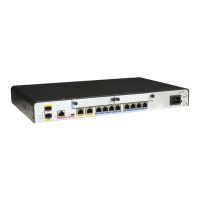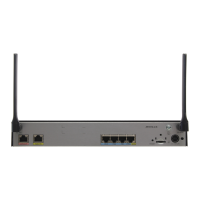1.1.1.1/32 Direct 0 0 D 127.0.0.1 Ethernet2/0/0
5.5.5.0/24 Static 60 0 RD 1.1.1.2 Ethernet2/0/0
Run the display mpls lsp command on the ASBR. If information about the LSP and label is
displayed, it means that the configuration succeeds. If the ASBR is enabled with the next-hop-
based label allocation, only one label is allocated for the VPN routes with the same next hop
and outgoing label.
<Huawei> display mpls lsp
-------------------------------------------------------------------------------
LSP Information: LDP LSP
-------------------------------------------------------------------------------
FEC In/Out Label In/Out IF Vrf Name
2.2.2.9/32 NULL/3 -/Pos1/0/0
2.2.2.9/32 1024/3 -/Pos1/0/0
3.3.3.9/32 NULL/3 -/Pos1/0/1
3.3.3.9/32 1025/3 -/Pos1/0/1
3.8 Configuring Inter-AS VPN Option C (Solution 1)
EBGP connections in multi-hop mode are established between PEs of different ASs to exchange
VPNv4 routes.
3.8.1 Establishing the Configuration Task
Before configuring inter-AS VPN OptionC, familiarize yourself with the applicable
environment, complete the pre-configuration tasks, and obtain the required data. This can help
you complete the configuration task quickly and accurately.
Applicable Environment
If the MPLS backbone network bearing VPN routes crosses multiple ASs, the inter-AS VPN is
needed.
If each AS needs to exchange a large number of VPN routes, inter-AS VPN-Option C is a good
choice to prevent the ASBR from becoming a bottleneck that impedes network expansion. Two
solutions can be adopted to realize inter-AS VPN-Option C:
l Solution 1: After learning the labeled BGP routes of the public network in the remote AS
from the remote ASBR, the local ASBR allocates labels for these routes and advertises
these routes to the IBGP peer that supports the label switching capability. A complete LSP
is set up as a result.
l Solution 2: The IBGP peer relationship between the PE and ASBR is not needed. In this
solution, an ASBR learns the labeled public BGP routes of the remote AS from the peer
ASBR. Then these labeled public BGP routes are imported to IGP to trigger the
establishment of an LDP LSP. This process can establish a complete LDP LSP between
the two PEs.
Solution 1 is described here, and solution 2 is described in 3.9 Configuring Inter-AS VPN
Option C (Solution 2).
Pre-configuration Tasks
Before configuring inter-AS VPN Option C, complete the following tasks:
Huawei AR1200 Series Enterprise Routers
Configuration Guide - VPN 3 BGP MPLS IP VPN Configuration
Issue 01 (2012-04-20) Huawei Proprietary and Confidential
Copyright © Huawei Technologies Co., Ltd.
105

